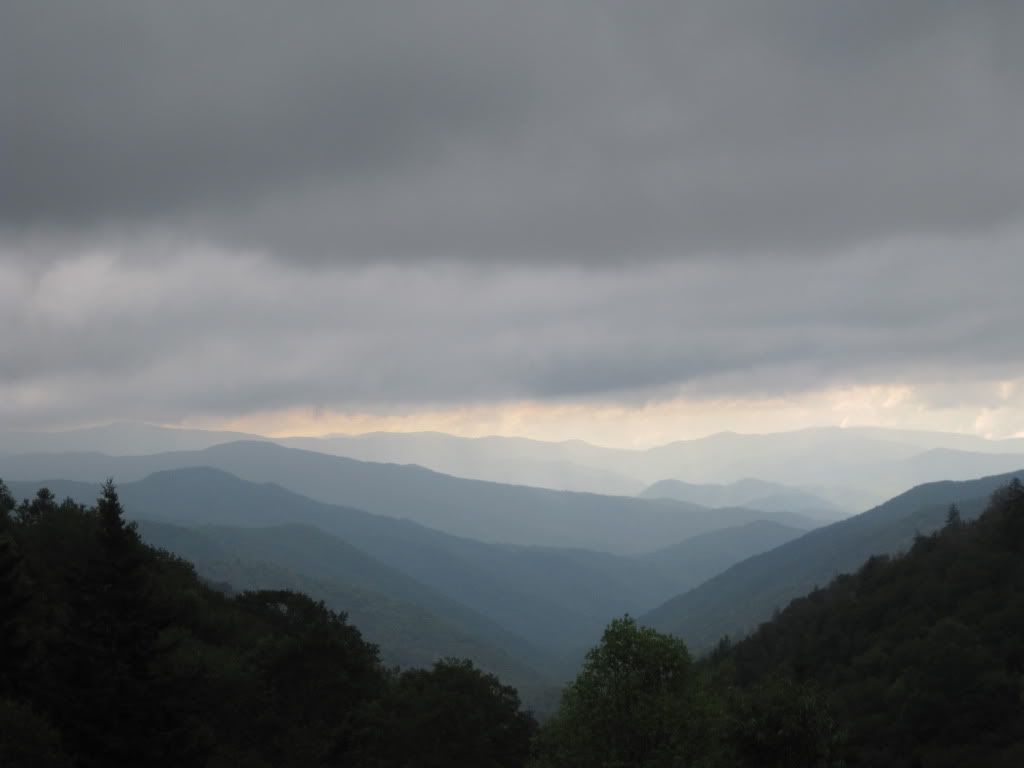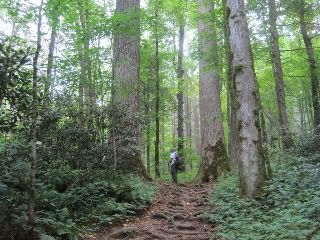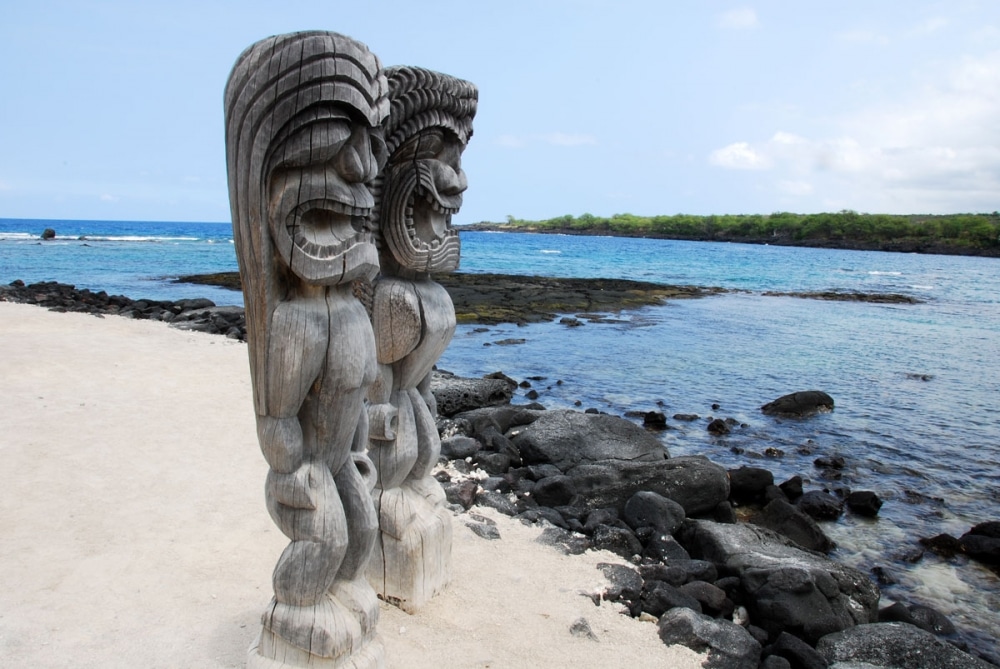 Estes Park, Colorado, is the gateway town to Rocky Mountain National Park. Much of its downtown was destroyed by flood in July 1982 when the Lawn Lake Dam burst. It was soon rebuilt, and those who oversaw the reconstruction did a good job. People still live in or close to the central business district, and while Estes Park obviously caters to tourists–there are fudge, ice cream, pizza, tee shirt, rock, souvenir, and antique shops; miniature golf courses; water slides and bumper cars–it does so while keeping the charm of a small town in a beautiful setting. Streets are tree- and flower-lined, and the Big Thompson River flows along a walking path behind the stores on the south side of the main street. We think that the outside seating at the Starbucks is the prettiest of any coffee shop in the country.
Estes Park, Colorado, is the gateway town to Rocky Mountain National Park. Much of its downtown was destroyed by flood in July 1982 when the Lawn Lake Dam burst. It was soon rebuilt, and those who oversaw the reconstruction did a good job. People still live in or close to the central business district, and while Estes Park obviously caters to tourists–there are fudge, ice cream, pizza, tee shirt, rock, souvenir, and antique shops; miniature golf courses; water slides and bumper cars–it does so while keeping the charm of a small town in a beautiful setting. Streets are tree- and flower-lined, and the Big Thompson River flows along a walking path behind the stores on the south side of the main street. We think that the outside seating at the Starbucks is the prettiest of any coffee shop in the country.
Unfortunately, all of this may change. A business group has proposed the building of a fifty-acre “adventure park,” dubbed the Elkhorn Project, which will include “year-round tubing and skiing, zip lines, alpine coaster, hiking, biking and horseback riding, a cultural center with performing arts center and museum.” The usual arguments are being made by the promoters: This will boost winter tourism; it will generate more revenue for the town; it will give residents a new leisure and cultural venue; and it will provide jobs. Our experiences in Estes Park suggest that these arguments won’t withstand careful scrutiny. Town folk are not particularly keen on cultural centers, nor will they be hired to work at the park since young part-time employees, many from foreign countries, do such work now. Estes Park already has sufficient revenue to do whatever public authorities in such towns typically do and to pay its top official six-figure salaries in the process. Winter tourism may increase, but this is not necessariy desirable to the locals, who enjoy the solitude of the cold and windy months when tourists don’t come. Furthermore, skiing has been mercilessly absent from Estes Park, helping to keep the mountains free of the “ski sprawl” that has made such a mess of places like Vail.
As is true for most such ventures, public money will be needed, and the directors of the Elkhorn Project soon had their hands out. They planned to apply for a Regional Tourism Act grant, which requires that a government entity submit the application and make public funds available for the project. After initially balking at the requests for money (including a $7,000,000 loan), the town eventually agreed to participate, file the application, and provide the necessary start-up cash. As part of the grant process, a request has been made to the state for a new sales tax to help finance the endeavor. The grantees haven’t been named yet, but if Estes Park is a winner, the Elkhorn Project will very likely be the forerunner of more such schemes.
Before Estes Park commits itself to “year-round tubing and skiing, zip lines and alpine coasters,” town officials should take a trip to Pigeon Forge and Gatlinburg, Tennessee. These are gateway communities to the north entrance to Great Smoky Mountains National Park. This park is one of the wonders of the world, and it is now a UNESCO World Heritage site. We recently spent a week hiking there, and we were struck by the beauty of dozens of clear mountain streams and waterfalls, plants and trees in great profusion and variety, the steepness of the hills, and the famous grey-blue haze that gives the Smokies their name. The UNESCO description of the park gives an idea of what a remarkable region this is:
The Great Smoky Mountains National Park is a major North American refuge of temperate zone flora and fauna that survived the Pleistocene glaciations. The park includes the largest remnant of the diverse Arcto-Tertiary geoflora era left in the world, and provides an indication of the appearance of late Pleistocene flora. It is large enough to allow the continuing biological evolution of this natural system, and its biological diversity exceeds that of other temperate-zone protected areas of comparable size. The park is of exceptional natural beauty with undisturbed, virgin forest including the largest block of virgin red spruce remaining on earth. . . . The Great Smoky Mountains is one of the most ecologically rich and diverse temperate zone protected areas in the world. There are over 1300 native vascular plant species, including 105 native tree species, plus nearly 500 species of non-vaxcular plants – a level of floristic diversity that rivals or exceeds other temperate zone protected areas of similar size. The park is also home to the world’s greatest diversity of salamander species. . . .
We were especially struck by this: “Since the park is relatively untouched, it gives an idea of temperate zone floral before the influence of mankind.”

The magnificence of the park contrasts dramatically with Pigeon Forge and Gatlinburg. Thes once small rural villages have become giant and garish boardwalks, replete with every kind of cheap and pathetic “entertainment,” from a Titanic museum in the shape of the famous ship (complete with an attached iceberg) to a Cooter’s Place featuring everything “Dukes of Hazzard.” There is about eight miles of this in Pigeon Forge and three miles in Gatlinburg. We didn’t walk around Pigeon Forge, but we did in Gatlinburg. This is not a pleasant experience. The smell of grease from scores of chain restaurants assails your nostrils; car and motorcycle traffic generates considerable air and noise pollution; and thousands of people walk around like zombies looking for food, drink, and entertainment. By their appearances, not many men, women, or children are capable of a hike, and indeed, on the treks we took, we didn’t see many hikers. On a segment of the Appalachian Trail, we met a minister who had been born in Gatlinburg. He said that the town of his youth had reached “new heights of tackiness.” He told us that people say they are going to the mountains but never leave the shopping areas.
Places like Pigeon Forge and Gatlinburg represent capitalism run amok. A beautiful area naturally attracts visitors–Rocky Mountain gets nearly three million and Great Smoky Mountains nine million a year. This tells local landowners that money can be made. So land is sold, and entrepreneurs open any business they think will turn a profit. A few families own most of the property in Gatlinburg and Pigeon Forge, including the Partons (whose most famous famous member, Dolly opened the Dollywood theme park: adult general admission is $57.25; the national park is free). Local politicians are only too happy to accommodate. Eventually Native American villages, ranches, and agriculture, and their attendant crafts and folkways disappear, replaced at best by ersatz Indian exhibitions and “craft villages” and at worst by the horrors of Pigeon Forge and Gatlinburg. The natural wonders nearby become a sideshow to the main attractions of mindless consumption and rustic nostalgia. Fortunately, Estes Park is not Gatlinburg. I hope it never is, but recent developments don’t make me optimistic.








Been to Estes and Gatlinburg/PF and you are so right about the destruction created by tourist enterprise & development run amok. It’s an extreme example of Garrett Hardin’s “Tragedy of the Commons” and so many wild and special places have been overrun as a result. The Florida Keys, much of Florida’s Gulf and Atlantic coasts and central highlands also come to mind.
Tourists still flock to the “beautiful” Keys and take cattle boats out to dive dead coral reefs. Because they’re just “passing through”, they rarely realize that they’re actually looking at a severely degraded, at-risk ecosystem, a shadow of a once vibrant, crystal clear world that has crumbled in the last 40 years since the Keys were “discovered” as a destination and developed way beyond their carrying capacity.
Education, self-awareness & participation are keys to sustainability, thanks for helping to model that future & pass it on.